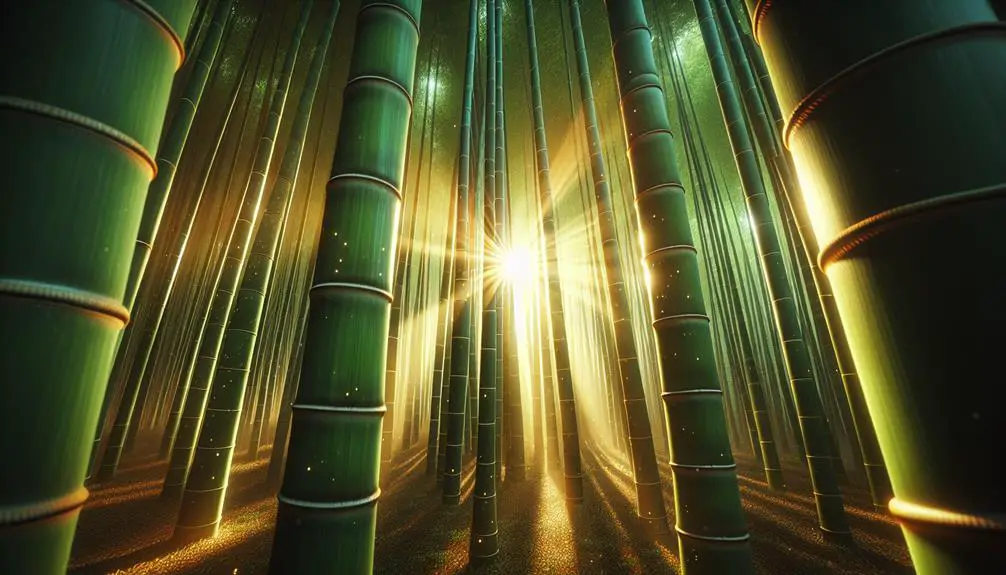Bamboo's a fascinating plant that belongs to the Bambusoideae subfamily within the grass family. It's known for its rapid growth, sometimes shooting up as fast as a foot per day under the right conditions! This sustainable resource forms either clumping or running types, with the latter often being invasive. Its incredibly strong yet lightweight nature makes it a popular choice in construction and various eco-friendly products. Bamboo plays a significant role ecologically by stabilizing soil and supporting wildlife. It even symbolizes resilience in different cultures. There's so much more to bamboo than meets the eye, isn't there?
Table of Contents
Key Takeaways
- Bamboo is a member of the Bambusoideae subfamily within the Poaceae family.
- It features clumping and running growth patterns, adapting to various environments.
- Bamboo is known for its rapid growth rate, strong root system, and ability to prevent soil erosion.
- It has a unique flowering cycle, flowering massively every 15 to 120 years.
- Bamboo is utilized in construction, cooking, and textiles due to its strength, flexibility, and sustainability.
Bamboo Taxonomy
Bamboo, with its over 1,400 species, falls under the Bambusoideae subfamily of the Poaceae family. It's fascinating to dive into its taxonomy, which is quite elaborate with divisions like Bambuseae, Olyreae, Arundinarieae, and Pooideae. Each of these contributes uniquely to the diversity of bamboo species around the globe.
Now, here's where it gets interesting for someone who's keen on understanding this diverse plant. The Bambuseae tribe, for instance, is primarily found in tropical regions and includes giants that can reach up to 30 meters! In contrast, the Olyreae, predominantly herbaceous and smaller, are adapted to understory environments of tropical forests. Meanwhile, the Arundinarieae are generally temperate species that you might find in cooler, mountainous regions.
Each tribe not only reflects the adaptability of bamboo to various climates but also its ecological roles in these environments. This extensive variety among the species of bamboo highlights why they're found everywhere from the lush jungles of Asia-Pacific to the savannas of sub-Saharan Africa and even in the Americas. Understanding these distinctions helps in appreciating how bamboo thrives across such diverse ecosystems and climates, showcasing its global ecological significance.
Growth and Ecology
Now, let's explore how bamboo grows and interacts within its ecosystem. Bamboo exhibits two primary growth patterns: clumping and running. These aren't just fancy botanical terms—they're crucial for understanding how fast and where bamboo spreads.
Clumping types tend to stay put, expanding slowly at the base, while running types shoot out underground rhizomes, popping up far from the original plant. Both types' growth rates are seriously impressive, often influenced by local conditions like soil type, climate, and water availability.
What's particularly fascinating about bamboo is its root system. It's not just about anchoring the plant; these roots play a pivotal role in preventing soil erosion. By forming a dense network, they help maintain soil stability, making bamboo an eco-hero in areas prone to landslides or heavy rainfall. Plus, their resilience to environmental stresses, such as storms or even earthquakes, underscores bamboo's reputation for toughness. This adaptability and minimal damage post-disaster show why many cultures symbolize bamboo with flexibility and durability.
Understanding these aspects is vital for anyone looking to master bamboo's ecological role and growth dynamics. It's not just a plant; it's a key player in its habitat.
Invasive Species Concerns
While running bamboo's ability to spread quickly can enhance its charm, it also raises concerns about its potential as an invasive species. This type of bamboo spreads rapidly through horizontal rhizomes, often overtaking other plant life in its path. This invasive behavior can disrupt local ecosystems, outcompeting native species for resources.
On the flip side, clumping bamboo species grow more vertically and maintain a tighter footprint. These varieties don't generally pose the same invasive species concerns as their running counterparts. If you're considering bamboo for your garden or a greening project, opting for clumping bamboo can help minimize ecological risks. It's a safer choice that's less likely to spread uncontrollably.
Understanding the distinct growth patterns of bamboo is key to managing its impact on surrounding environments. While bamboo can be a fantastic, sustainable resource, it's crucial to choose species that align with local ecological goals. For those involved in tree planting or restoration projects, incorporating clumping bamboo can contribute positively without the worry of it becoming an invasive threat. Being informed and selective about the type of bamboo you plant is essential for both enjoying its benefits and protecting native biodiversity.
Bamboo Flowering Cycles
One of the most intriguing aspects of bamboo is its rare and unpredictable flowering cycle. Bamboo species have this unique reproductive trait where they flower massively every 15 to 120 years! Imagine waiting decades for a single bloom—talk about patience. This isn't just a quirky plant behavior; it has profound ecological impacts. When bamboos flower, they do so synchronously across the whole species, no matter where they're located. This synchronization can lead to massive seed production followed by the death of mature plants.
Now, here's where it gets even more interesting. The death of these bamboos after flowering can dramatically alter ecosystems. It affects not just the plant life but also the myriad of creatures that rely on bamboo forests for shelter and food. Local communities who depend on bamboo for their livelihoods face challenges too. The whole cycle is crucial for bamboo's reproduction and growth patterns, but it also throws a wrench into the usual ecological dynamics.
Each bamboo species has its own timetable and style of flowering, some with gregarious events and others more sporadic. Understanding these cycles helps us grasp not only the biology of bamboo but also its broader environmental role.
Cultivation Techniques
As we turn to bamboo cultivation techniques, it's crucial to focus on how we prep the soil and adapt to different climates.
I've found that matching the soil type to the bamboo species can drastically affect their growth and health.
We'll also look into how these plants can thrive across various weather conditions, ensuring they perform their best.
Soil Preparation Methods
To kick off our discussion on soil preparation methods for bamboo, it's crucial to start by clearing the land of any weeds and debris. This sets the stage for a clean planting environment.
Next, I make sure the soil pH levels are just right, aiming for between 5.5 to 6.5, which is ideal for bamboo. Adding organic matter, like compost or manure, is my next step to boost soil fertility and improve its structure, ensuring the bamboo thrives.
I also deep plow or till the soil to about 30-45 cm deep. This helps the roots penetrate better and absorb nutrients efficiently.
Lastly, I apply a layer of mulch, such as leaves or straw, to maintain moisture, suppress weeds, and regulate soil temperature.
Climate Adaptation Strategies
After prepping the soil, it's time to focus on how different bamboo species respond to various climates. Choosing the right species for your local weather is crucial. You've gotta plant bamboo at just the right time to make sure it gets a good start.
I've found that proper irrigation can really help your bamboo cope with different climate conditions. Don't forget mulching—it's great for keeping the soil moist and stable, temperature-wise. Sometimes, you might even need to throw in some shading or windbreaks if you're dealing with really tough weather conditions.
All these steps are vital for adapting your bamboo production to thrive despite the challenges posed by climate change.
Harvesting Methods
Harvesting bamboo involves using either hand tools like machetes or more efficient automated machinery, depending on the project's needs. When targeting bamboo for construction, it is essential to pay close attention to the growth cycle to ensure cutting mature culms at their peak strength. This not only provides superior materials but also supports sustainable growth by allowing younger shoots to thrive.
To give you a clear picture, here are key points to consider:
- Selective Cutting: This method promotes ecosystem balance and ensures only mature stalks are harvested, allowing younger ones to develop.
- Timing is Crucial: Harvesting at the right time maximizes strength and quality, typically between three to five years after a culm has sprouted.
- Tool Choice: Depending on scale, machetes might be used for small projects, while larger operations might require mechanical cutters.
- Sustainable Practices: By cutting at the base, new shoots can grow from the stump, ensuring a continuous supply without damaging the plantation.
Using these methods, I make sure the bamboo I harvest is ideal for my construction projects, maintaining both the health of the bamboo forest and the quality of my building materials.
Bamboo in Animal Diets
Bamboo isn't just for building; it's a crucial part of the diet for many animals, from giant pandas to small caterpillars. Dive into how this versatile plant sustains various wildlife species.
Giant pandas are the poster animals for bamboo lovers; they munch on bamboo leaves for about 99% of their diet. This isn't just a preference—it's survival. The leaves provide minimal energy, so pandas eat up to 38 kilograms daily to meet their needs. But it's not just about these charismatic giants. Bamboo shoots, packed with nutrients, are a favorite for species like elephants and gorillas, offering them essential dietary fiber and proteins.
Insects such as bamboo worms thrive on bamboo, and in doing so, attract a variety of birds and predators, creating a dynamic ecosystem around this single plant species. Moreover, when bamboo seeds drop, they become a vital food source for rodents and small mammals, supplying them with crucial nutrients.
Here's a quick snapshot of who eats what in the bamboo buffet:
| Animal | Part of Bamboo Consumed |
|---|---|
| Pandas | Leaves |
| Elephants | Shoots |
| Bamboo Worms | Plant |
| Small Mammals | Seeds |
Bamboo's role extends beyond simple nutrition; it's a cornerstone of survival for these creatures.
Bamboo Uses
Bamboo isn't just for pandas; I've found it's incredibly versatile in everyday life too.
It's a star in the kitchen as a source of nutritious shoots and even pops up in our buildings and furniture because of its strength.
Plus, it's making waves in the fashion industry as a source of eco-friendly textiles.
Construction and Building Materials
I've discovered that due to its high tensile strength, bamboo is an incredibly strong and flexible material for construction. It's not just about being tough; its flexibility is a game-changer, especially in earthquake-prone areas. Here's why you should consider bamboo for your next project:
- Sustainability: It's a renewable resource that helps combat deforestation.
- Versatility: From scaffolding to intricate structural components, bamboo does it all.
- Fire Resistance: Enhances safety in fire-prone regions, adding an extra layer of security.
- Earthquake Resilience: Its natural flexibility allows it to absorb impacts, making buildings safer during seismic activities.
Culinary Applications
Let's dive into how bamboo is revolutionizing the culinary world, beyond just its use in construction. Bamboo shoots, a staple in Asian cuisine, aren't just tasty—they're packed with nutrients. They're low in calories but high in fiber and potassium, making them a superb choice for anyone looking to boost their diet.
Beyond the shoots, bamboo leaves serve as aromatic wrappers for foods like sticky rice, enhancing flavors through steaming. Even bamboo charcoal comes into play, purifying water and regulating humidity when cooking.
And let's not overlook bamboo utensils—steamer baskets and skewers have been essential in traditional Asian kitchens for ages. Each of these culinary applications showcases bamboo's versatility and sustainability in cooking practices.
Eco-Friendly Textile Production
Turning to the realm of eco-friendly textile production, bamboo stands out due to its sustainable growth characteristics and minimal chemical needs. As one of the fastest-growing plants, it's reshaping how we think about sustainable fashion. Here's why bamboo is a top choice:
- Rapid Growth: Bamboo thrives without pesticides or fertilizers, reducing environmental strain.
- Natural Benefits: Fibers are antibacterial, hypoallergenic, and moisture-wicking.
- Soft and Strong: Textiles made from bamboo aren't only comfortable but also durable.
- Eco-Friendly Processing: Utilizes a closed-loop system that recycles solvents.
Adopting bamboo in textile production isn't just good for the environment; it's a smart, sustainable choice for future-focused fashion.
Bamboo as Building Material
Bamboo's flexibility and strength make it an excellent choice for building in areas prone to earthquakes. Its natural properties allow it to absorb shocks and stresses that might cause conventional materials like concrete or steel to crack or break. I've seen it stand up to some of the toughest conditions, making it not just a viable, but a preferred material for construction in such zones.
Beyond its seismic resilience, bamboo is incredibly versatile. It's used as a raw material for creating everything from houses to bridges. Imagine scaffolding that's both lightweight and robust, simplifying construction without sacrificing safety. That's bamboo for you. Its lightweight nature doesn't just ease the physical aspect of building—it also cuts down on transport costs, making projects more economically feasible.
Moreover, bamboo's high silicate acid content gives it a remarkable resistance to fire. In regions where wildfires are common, using bamboo can be a game-changer, offering an extra layer of protection to structures. It's amazing how this one material can provide so much—structural integrity, cost-effectiveness, and safety—all while being naturally sourced. It's no wonder it's becoming a go-to choice for more and more builders globally.
Bamboo and Sustainability
I've always been amazed at how quickly bamboo grows, making it a powerhouse in carbon sequestration. Its rapid growth allows it to absorb carbon dioxide much faster than traditional trees, which is great for tackling climate change.
Plus, bamboo's versatility as an eco-friendly material means it's popping up in everything from clothing to building materials.
Bamboo Growth Rate
Some bamboo species can shoot up a staggering 2.91 feet in just one day, making them one of the fastest growers in the plant kingdom. Here's what's fascinating about their rapid growth:
- Emergence and Maturity: Bamboo shoots burst from the ground and can reach full size in about 60 days.
- Stimulated Growth: Regular cutting doesn't harm these giants; it actually prompts the growth of new shoots and leaves.
- Regeneration Speed: More frequent harvesting leads to quicker regeneration, ensuring a sustainable crop.
- Carbon Sequestration: While I'll dive deeper into carbon sequestration benefits later, it's worth noting that the growth of new bamboo plays a crucial role in carbon capture.
This incredible growth rate not only supports sustainability but also showcases bamboo's potential in ecological restoration and economic stability.
Carbon Sequestration Benefits
Building on its rapid growth, bamboo also excels in carbon sequestration, significantly aiding climate change mitigation.
You see, bamboo can sequester up to 1.78 tonnes of CO2 per clump each year. That's a lot, especially when you consider it has a carbon drawdown rate 10 times faster than woody trees.
What makes bamboo even more impressive is that with the right management and harvesting practices, we can further boost its carbon sequestration capabilities. Its dense roots and fast-growing nature make it an exceptional tool for sustainable carbon absorption and offsetting.
This makes bamboo not just a plant, but a powerful ally in our fight against climate change. By leveraging bamboo, we're really tapping into a robust resource for environmental sustainability.
Eco-Friendly Material Uses
Bamboo's versatility as an eco-friendly material makes it a top choice for sustainable construction and design. As we dive deeper into its uses, it's clear why it's celebrated by environmentalists and builders alike. Here's why:
- Carbon Sequestration: Bamboo sequesters up to 1.78 tonnes of CO2 per clump annually, drastically reducing greenhouse gases.
- Water Management: Its dense root system prevents erosion and can be used in sustainable wastewater treatments.
- Fire Resistance: The material contains large amounts of silicate acid, making it naturally flame-resistant, which is crucial in fire-prone areas.
- Sustainable Building Material: Using bamboo saves trees and offers a robust alternative to traditional building materials like wood, steel, and bricks.
It's no wonder bamboo is a favorite in eco-friendly circles!
Cultural Significance
I've always marveled at how bamboo, through its elegance and versatility, has woven itself into the fabric of East Asian culture. The cultural significance of this plant is deeply rooted in its unique characteristics. Bamboo isn't just about its hardy, fast-growing nature; it's about how these traits translate into a symbol of resilience and flexibility in art, poetry, and everyday life.
Let's dive into some specific ways bamboo marks its importance across various aspects of culture:
| Use in Culture | Details |
|---|---|
| Art and Poetry | Featured in numerous works, symbolizing strength and grace. |
| Traditional Medicine | Silica from joints used for healing in various ailments. |
| Daily Life | Utilized for making tools, buildings, and crafts. |
| Culinary Traditions | Integral in foods and as cooking tools in Asian cuisine. |
Each of these uses highlights how the characteristics of bamboo enhance its cultural significance. Whether it's in a delicate painting or a robust building, bamboo represents a bridge between the natural world and human creativity, making it a staple in cultural expressions and practical applications alike.
Global Bamboo Distribution
While bamboo thrives mainly in tropical and subtropical zones, its presence spans globally, adapting to various climates from mild temperate regions to the islands in the Indian and Pacific oceans. It's fascinating to see how this versatile plant has spread far and wide, finding niches in diverse environments.
Here's a quick bullet list to show you where bamboo stands out globally:
- East and Southeast Asia: This is the hotspot for bamboo, hosting the highest concentration and species diversity. It's not just about pandas munching on bamboo; these regions rely on it for building materials, food, and cultural artifacts.
- Southern United States: Surprisingly, bamboo has taken root here too, particularly species from the Arundinaria genus which create extensive canebrakes.
- Mild Temperate Climates: Beyond the tropics, certain bamboo species have adapted to cooler, milder temperate climates, showcasing the plant's versatility.
- Indian and Pacific Oceans: Islands here also see bamboo growth, contributing to the local ecosystems and economies.
Bamboo's ability to adapt across different climates and its usefulness in various cultural and economic contexts truly make it a global player in the plant kingdom. Whether it's crafting traditional items or supporting biodiversity, bamboo's role is indispensable.
Frequently Asked Questions
What Are the Characteristics of Bamboo?
I'm exploring bamboo's traits; it's notably strong, flexible, and grows incredibly fast. Its hollow structure supports resilience against storms and its dense root system combats soil erosion, embodying adaptability and strength.
What Is so Special About Bamboo?
I'm fascinated by bamboo because it's incredibly strong, grows super fast, and helps fight erosion. Plus, it absorbs a ton of CO2, making it a champion in the fight against climate change.
What Are 5 Interesting Facts About Bamboo?
I've learned that bamboo can shoot up 30 cm daily, spans heights up to 40 meters, and boasts a high strength-to-weight ratio due to its hollow structure, making it perfect for various uses.
What Bamboo Symbolizes?
I've learned that bamboo symbolizes strength, flexibility, continuous growth, and durability. It stands strong like steel, bends without breaking, grows rapidly, and resists damage from natural disasters, embodying resilience and simplicity.
- Fabrics in Culture: A Global Exploration - July 24, 2024
- The Evolution of Textile Patterns Through History - July 24, 2024
- Exploring Traditional Fabrics From Different Cultures - July 24, 2024








